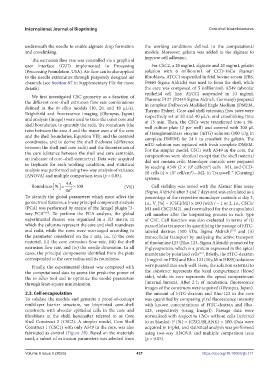Page 445 - IJB-9-5
P. 445
International Journal of Bioprinting Core-shell bioarchitectures
underneath the needle to enable alginate drop formation the working conditions defined in the computational
and crosslinking. models. Moreover, gelatin was added to the alginate to
The extrusion flow rate was controlled via a graphical improve cell adhesion.
user interface (GUI) implemented in Processing For CSC2, a 20 mg/mL alginate and 20 mg/mL gelatin
(Processing Foundation, USA). Air flow can be also applied solution with 6 million/mL of CCD-18Co (human
to the needle extremities through purposely designed air fibroblasts, ATCC) suspended in fetal bovine serum (FBS,
channels (see Section S7 in Supplementary File for more F9665 Sigma Aldrich) was used to form the shell, while
details). the core was composed of 5 million/mL A549 (alveolar
epithelial cell line, ATCC) suspended in 10 mg/mL
We first investigated CSC geometry as a function of Pluronic F127 (P2443 Sigma Aldrich, Germany) prepared
the different core–shell extrusion flow rate combinations in complete Dulbecco’s Modified Eagle Medium (DMEM,
defined in the in silico models (10, 20, and 40 μL/s). Thermo Fisher). Core and shell extrusion flow rates were
Brightfield and fluorescence imaging (Olympus, Japan) respectively set at 20 and 40 μL/s, and crosslinking time
and analysis (ImageJ) were used to trace the outer core and at 15 min. Then, the CSCs were transferred into a 96-
shell boundaries, to quantify the radii, the roundness (the well culture plate (2 per well) and covered with 300 µL
ratio between the area A and the major axes a of the core of transglutaminase enzyme (mTG) solution (100 U/g in
and the shell boundaries, Equation VII), and the centroid complete DMEM) for 24 h to crosslink the gelatin. The
coordinates, and to derive the shell thickness (difference mTG solution was replaced with fresh complete DMEM.
between the shell and core radii) and the decentration of For the simpler model, CSC1 with A549 in the core, the
the core (distance between the shell and core centroids, compositions were identical except that the shell material
an indicator of core–shell symmetry). Data were acquired did not contain cells. Monolayer controls were prepared
in triplicate for each working condition, and statistical by seeding A549 (2 × 10 cell/cm ) cells—M1, and CCD-
2
5
analysis was performed using two-way analysis of variance 18 cells (4 × 10 cell/cm )—M2, in Transwell ® (Corning)
2
5
(ANOVA) and multiple comparison tests (p < 0.05). systems.
4A
Roundness% a 2 100 (VII) Cell viability was tested with the Alamar Blue assay
To identify the global parameters which most affect the (Sigma Aldrich) after 3 and 7 days and was calculated as a
percentage of the respective monolayer controls at day 3,
geometrical features, a 3-way principal component analysis i.e., V [%] = (CSCi/Mi) × 100 (with i = 1 or 2, i.e., CSC1/
i
(PCA) was performed by means of the ImageJ plugin “3- M1 and CSC2/M2), and normalized for the encapsulated
way PCA” . To perform the PCA analysis, the global cell number after the bioprinting process in each type
[33]
experimental dataset was organized in a 3D matrix in of CSC. Cell function was also evaluated in terms of (i)
which the columns represent the core and shell roundness paracellular transport by quantifying the passage of FITC-
and radii, while the rows were rearranged according to labeled dextran (500 kDa, Sigma Aldrich) and (ii)
[34]
the parameter considered on the z axis, i.e., (i) the core transcellular transport by analyzing the active transport
material, (ii) the core extrusion flow rate, (iii) the shell of rhodamine 123 (Rho-123, Sigma Aldrich) promoted by
extrusion flow rate, and (iv) the needle dimension. In all P-glycoprotein, which is a protein expressed in the apical
cases, the principal components identified from the plots membrane by polarized cells . Briefly, the FITC-dextran
[35]
corresponded to the core radius and its roundness. (5 mg/mL in PBS) and Rho-123 (10 µM in HBSS) solutions
Finally, the experimental dataset was compared with were poured into each well. Here, the solution external to
the computational data to assess the predictive power of the construct represents the basal compartment (blood
the in silico tool and to optimize the model parameters side), while its core represents the apical compartment
through least-square minimization. (internal lumen). After 2 h of incubation, fluorescence
images of the constructs were acquired (Olympus, Japan).
2.3. Cell encapsulation The amount of FITC-dextran and Rho-123 in the core
To validate the models and generate a proof-of-concept was quantified by comparing pixel fluorescence intensity
multilayer barrier structure, we bioprinted core–shell with known concentrations of FITC-dextran and Rho-
constructs with alveolar epithelial cells in the core and 123, respectively (using ImageJ). Passage data were
fibroblasts in the shell, hereinafter referred to as Core normalized with respect to CSCs without cells (referred
Shell Construct 2 (CSC2). A simpler model, Core Shell to as blanks): P [%] = (CSCi/BLANK) × 100. Data were
Construct 1 (CSC1) with only A549 in the core, was also acquired in triplet, and statistical analysis was performed
fabricated as control (Figure 2B). Based on the materials using two-way ANOVA and multiple comparison tests
used, a subset of extrusion parameters was selected from (p < 0.05).
Volume 9 Issue 5 (2023) 437 https://doi.org/10.18063/ijb.771

